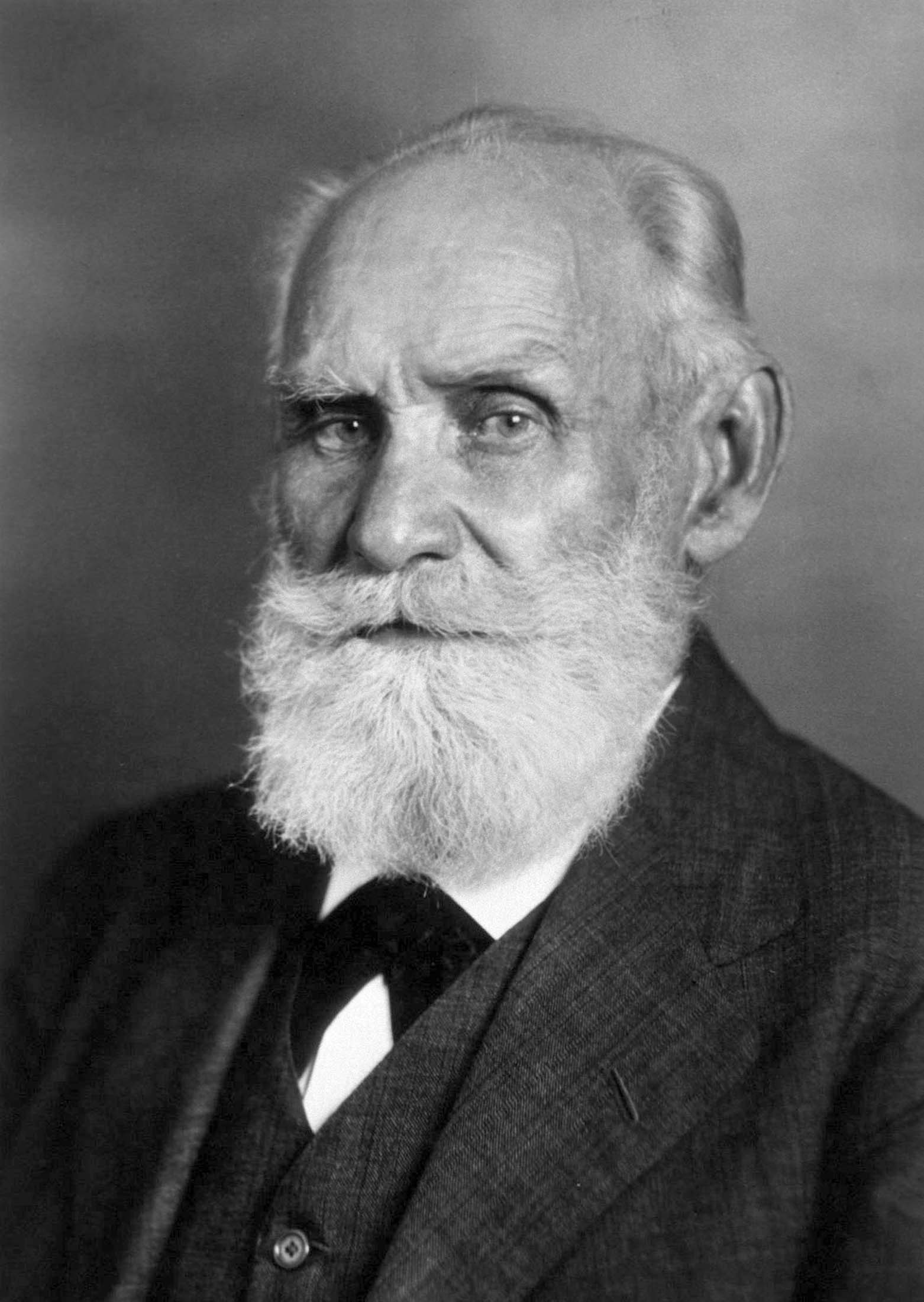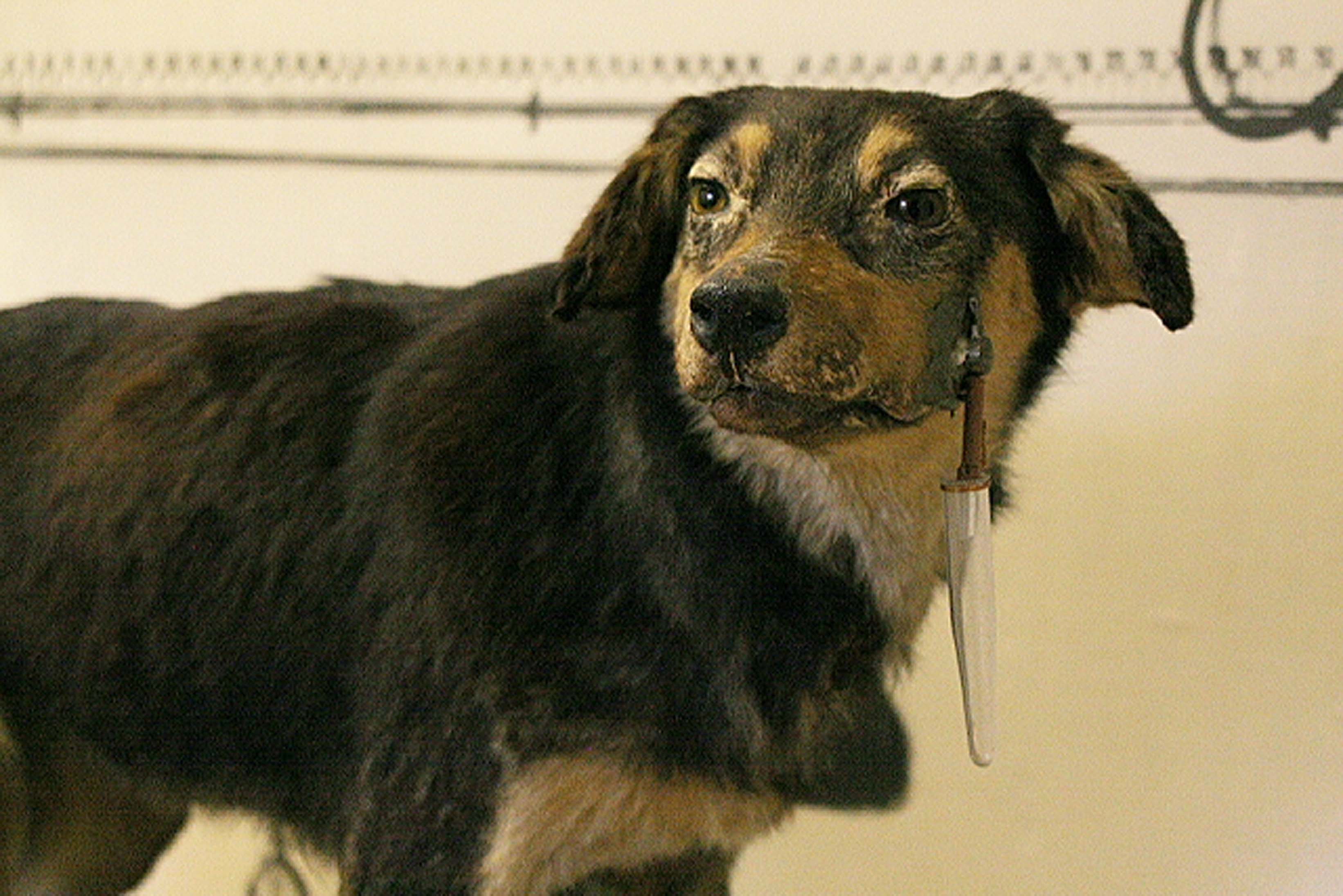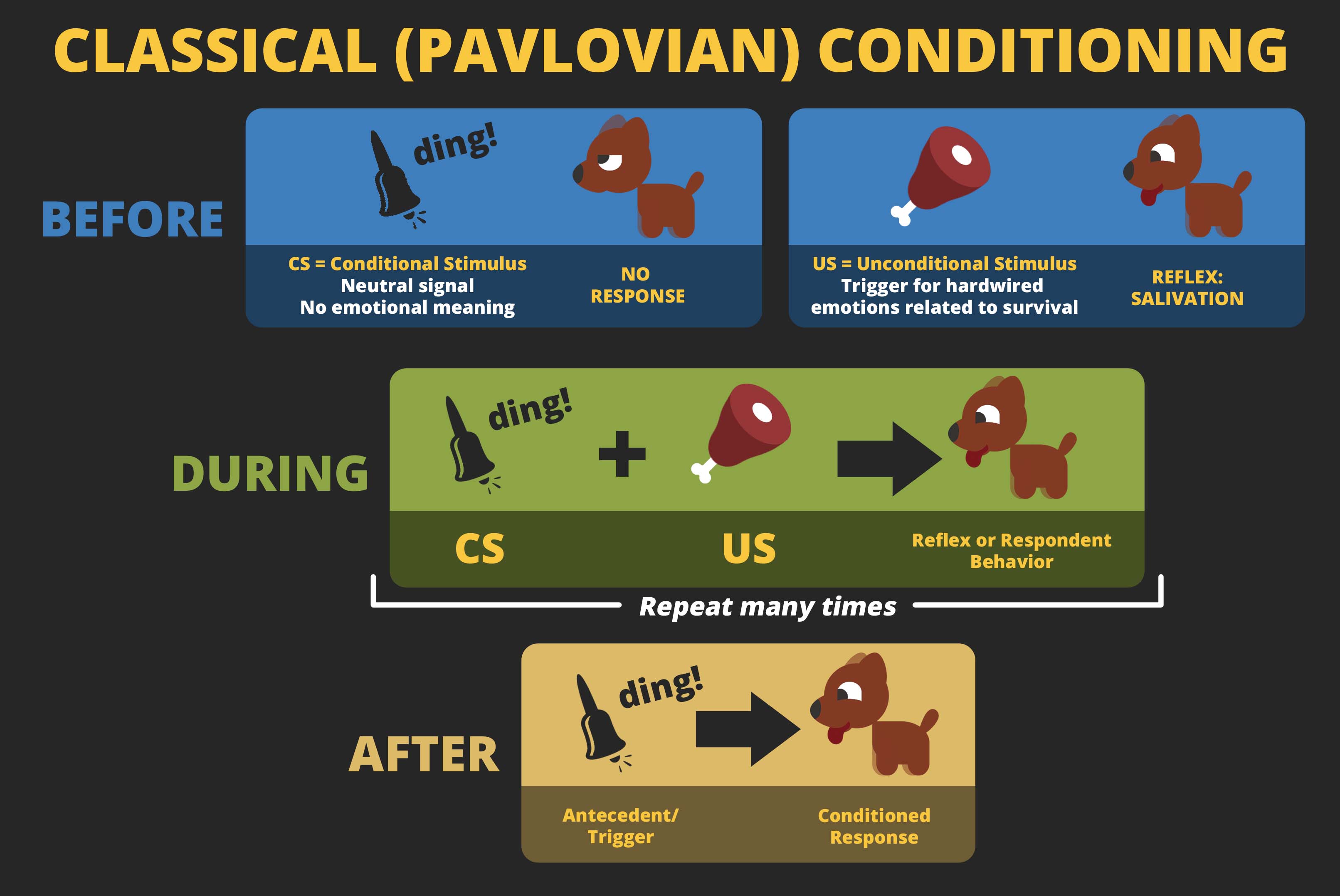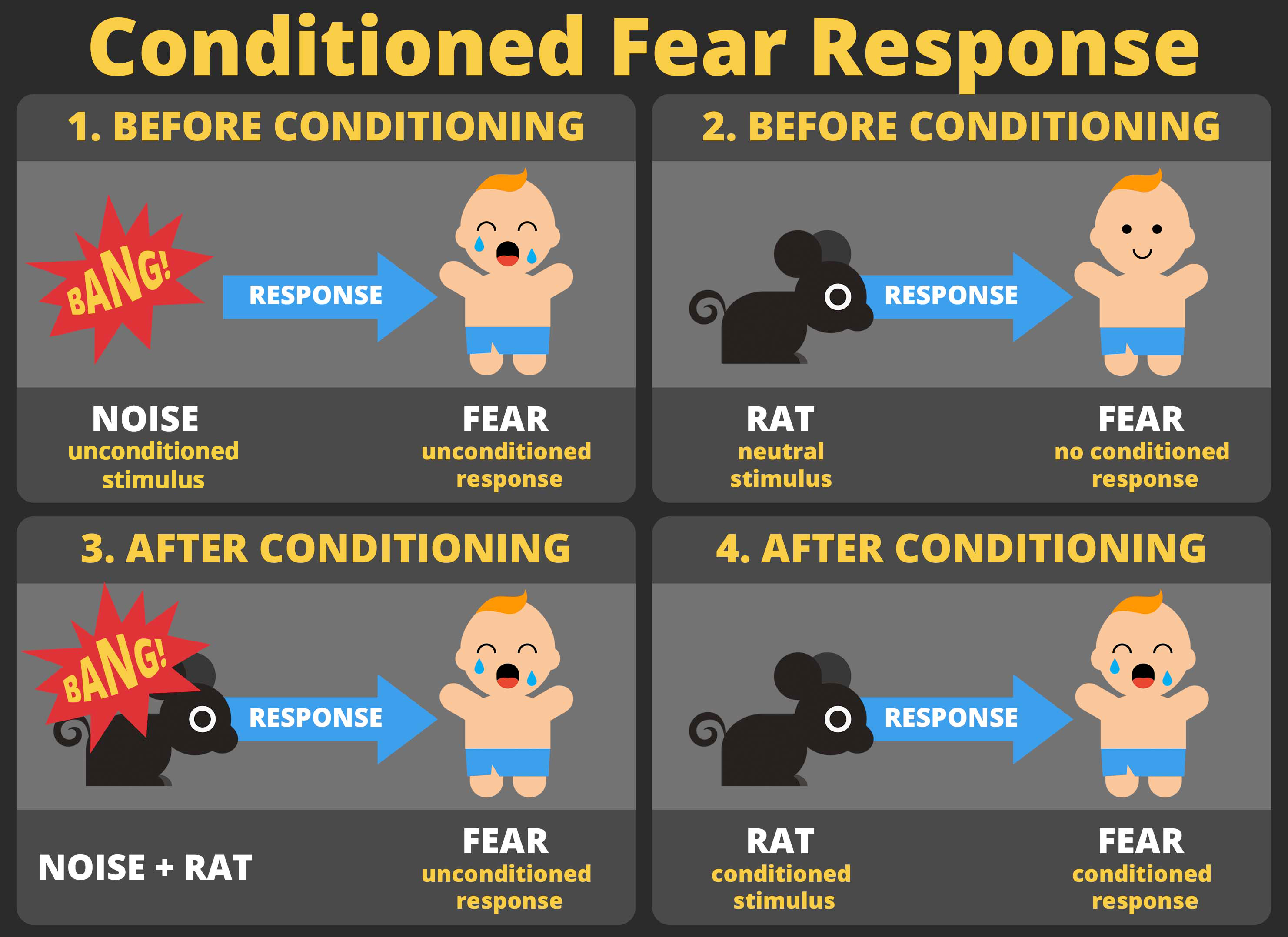Classical Conditioning
Note to students: The best preparation for taking the reading quiz is to pay close attention to the key terms as you read. Each question in the question banks is directly linked to these key terms and phrases.
Chapter Focus Question:
What is the significance of classical conditioning in explaining how human behaviors develop?
- Ivan Pavlov
- Evolutionary preparedness
- Reflexive responses
- Neutral stimulus (NS)
- Conditioned stimulus (CS)
- Conditioned response (CR)
- Unconditioned stimulus (US)
- Unconditioned response (UR)
- NS transition to CS
- Extinction
Section Focus Question:
How were Ivan Pavlov’s experiments groundbreaking in the field of human behavior?
Key Terms:
Did you know that the particular environment in which a person takes a drug, such as heroin, can influence whether that person lives or dies? Why would rats live or die after getting an overdose of heroin just because they did or did not hear a tone before receiving the injection of heroin? We will provide the details at the end of this section, but the answer to these questions is classical conditioning and evolutionary preparedness.
Classical conditioning is an important and powerful form of learning that involves reflexes and associations between stimuli and responses. Why is it important? Classically conditioned responses have the power to weaken the immune system, produce emotional responses, lead to drug relapse, result in phobias, and even produce aversion to food. Is there a particular smell, say — perfume or food — which reminds you of someone or some past event? These types of experiences result from classical conditioning.
Ivan Pavlov (1849-1936), a Russian physiologist, discovered classical conditioning by accident while studying the physiology of the digestive glands using dogs’ salivary responses. What is interesting about Pavlov’s discovery is that (1) it was not expected, and (2) he followed up on his serendipitous finding. In fact, he made this research his life’s work. Pavlov collected the saliva from dogs that were fitted with a special tube. To collect the saliva, Pavlov would put meat powder in the dog’s mouth and the meat powder automatically caused the dog to salivate. Salivation is an unlearned reflex. Reflexes occur automatically, without any prior learning, in response to particular stimuli.

A “stimulus” is any event that elicits a response. Just like meat powder in the dog’s mouth, if you were to eat a sour candy, you would automatically salivate. Reflexes serve an evolutionary advantage because we are biologically predisposed to have particular responses to various stimuli, and those responses aid us in our survival. In addition to salivation, other reflexive responses include blinking your eyes, a newborn’s suckling and grasping, sneezing, and being startled when you hear a loud, unexpected noise. In Pavlov’s experiments, the meat powder is termed an “unconditioned stimulus” (US). A US is a stimulus that automatically causes a reflex called an “unconditioned response” (UR) to occur without prior learning. The dog’s reflexive response to the meat power, salivation, is a UR.
One day, when Pavlov approached one of his dogs to deliver the meat powder, the dog started salivating before the meat powder was put in its mouth! Pavlov was more than surprised, and he wondered how and why the dog could salivate when it hadn’t yet had the meat powder delivered. Put differently, how could the unconditioned response (salivation) occur when the unconditioned stimulus (meat powder) was not yet presented? Pavlov hypothesized that, somehow, his presence caused the dog to salivate; he suspected that there must have been an association between his presence and the dog salivating. So, he set out to determine what processes resulted in this phenomenon through a series of experiments.
Note the saliva catch container and tube which are surgically implanted in the dog's muzzle.

In Pavlov’s now famous experiments, he began by presenting a “neutral stimulus” (NS); in this case he used a metronome, which produced certain sounds. At first, the tone (NS) was presented alone. This was done to ensure that the dog was able to perceive the sound. When the tone was presented, the dog raised its ears and looked in the direction toward where the sound occurred, indicating that it heard it. Looking in the direction of the metronome is called an “orienting response.” This step in the classical conditioning process is important because we need to ensure that the organism (dog, cat, human, etc.) can actually perceive the stimulus.
Pavlov then began the conditioning process, which is as follows: First, the sound was repeatedly paired with the US, in this case the meat powder. By paired, we mean presenting the sound and immediately following it with the presentation of the meat powder. This was done several times (present the sound, put the meat powder in the dog’s mouth repeatedly). Second, to test to see if conditioning occurred, the sound was presented alone (not followed by meat powder). If the dog salivated to the sound, it demonstrated that classical conditioning had occurred. In other words, the NS could now produce the salivation response by itself.
After conditioning has occurred, the former NS (in this case, the sound) is now termed a “conditioned stimulus” (CS). When the dog salivates to the sound alone, the salivation is termed a “conditioned response” (CR), which is a response that occurs in the presence of a CS alone. The essence of classical conditioning is that the presentation of the conditioned stimulus (CS) predicts the occurrence of the unconditioned stimulus (US). In this example, the sound predicted the presentation of the meat powder. Said another way, an association between the sound and the presentation of food was developed. It turns out that Pavlov was correct in his hypothesis that the sight of him caused the dogs to salivate because his presence predicted the presentation of meat powder. That is, Pavlov became a CS that predicted the presentation of the US (meat powder). The dog’s salivation to the presence of Pavlov alone was a CR.
The process of classical conditioning begins with “acquisition” of the response. This occurs via the repeated pairings of the conditioned and unconditioned stimuli and results in the conditioned stimulus (CS) eliciting the conditioned responses (CR). However, what happens if we continue to present the conditioned stimulus (CS) but never present the unconditioned stimulus (US)? Failing to at least periodically present the US after the CS will result in extinction. Extinction results in a weakening of the ability of the CS to elicit the CR. This occurs because the CS no longer predicts the presentation of the US, which is the essence of classical conditioning. However, even after extinction it is possible for the conditioned stimulus (CS) to elicit the conditioned response (CR), a process called “spontaneous recovery.” The CR may not be as strong as it was prior to extinction, but it occurs nonetheless. For example, during the acquisition phase, a dog may salivate 10 drops to a sound (CS); after extinction and a rest period, the CS may elicit only five drops of saliva.

- Nausea
- Chemotherapy
- Food poisoning
- Conditioned taste aversion
- Taste aversion and livestock predation
Section Focus Question:
How can classical conditioning help us explain changes or reversals in reflexive behavior, and what are some practical applications of these findings?
Key Terms:
Pavlov demonstrated experimentally that after repeated pairings of a neutral stimulus with an unconditioned stimulus that a formerly neutral stimulus becomes a conditioned stimulus, which then produces a conditioned response. This powerful discovery has practical, real-life implications, which has led to robust study of how classical conditioning can produce reflexive responses. As an example, knowledge of classical conditioning helps doctors educate cancer patients about their diets while they undergo chemotherapy. In addition to a variety of unpleasant side effects, chemotherapy can result in nausea and vomiting. We can see the chemotherapy as a US that results in a UR (nausea and vomiting).
If a patient eats a preferred food while undergoing chemotherapy, that food may be paired with the resulting sickness. Because of this pairing, future encounters with that food, even in the absence of chemotherapy, may result in nausea and vomiting. This is called a conditioned taste aversion. One way doctors can help patients avoid such conditioned taste aversions is to prescribe anti-nausea drugs, which would prevent the pairing of food and nausea from occurring. They can also provide recommendations on which foods to avoid and time frames for when it is safe to eat preferred foods to avoid conditioning.
“Conditioned taste aversion” is a biologically relevant reflex and defense mechanism as it conditions the organism to avoid the substance it ate that resulted in sickness. Avoiding a particular food item after food poisoning is an excellent example of conditioned taste aversion. People and other organisms avoid the foods that have resulted in their poisoning. From an evolutionary perspective, it makes sense that we would avoid food that has made us sick. Interestingly, scientists have used this knowledge to help farmers and others who deal with predators who prey on their livestock.
For example, if a coyote is preying on a farmer’s sheep, scientists could taint some sheep meat and leave it out for the coyote. When the coyote eats the tainted meat, it develops a conditioned taste aversion and will avoid killing sheep for their meat in the future. One way in which conditioned taste aversion is somewhat different from the basic classical conditioning procedure is that it can result after one pairing. It usually requires several pairings of the NS and US for the NS to become a CS and elicit a response. Another way that it differs is that the time frame between the presentation of the NS (food) and the resulting sickness (US) can be much longer than in typical classical conditioning procedures to be effective (several hours may pass between the NS and US). Generally speaking, classical conditioning usually occurs when the NS and US are separated by only a few seconds.
- Phobias
- Single-pairing classically conditioned response
- Conditioned fear response theory
- Role of environment in overdose
- Conditioned toleration
- Weakened immune system
- Drug relapse
Section Focus Question:
How does environment shape behavior, and why do phobias develop as they do?
Key Terms:
Another example of a classically conditioned response that only requires one pairing is a phobia. A “phobia” is an extreme or irrational fear of, or aversion to, something. For example, a person may only have to be stung once by a bee to develop a phobia of bees. Here, the sting from the bee is the US and the resulting pain and fear are URs; after that one pairing, the sight (and even sound) of a bee may become a CS and the resulting fear a CR (also termed a “conditioned fear response”).
If we wanted to extinguish the fear response to bees, as described above, we would have to present the bees (sight and sound), which are the CSs, without presenting the US (the sting). Unfortunately, however, people with phobias go to great lengths to avoid the feared stimuli that caused their phobias, so there may not be an opportunity for extinction to occur. That said, there are very effective behavioral therapies that use extinction to help treat people with phobias; these are discussed in the section on Applications of Classical and Operant Conditioning.
Now, let’s go back to the example from the beginning of this section and explain how the environment in which a person takes a drug can influence whether or not that person overdoses. Through a series of experiments, Shepard Siegel demonstrated the importance of CSs in the likelihood of a person overdosing. He observed that many people who were addicted to heroin overdosed when they injected the drug in a different environment from where they usually took heroin.
How could simply taking the drug in a different place result in overdose? Using different groups of rats injected with heroin, he found that the CSs associated with the injection of the drug actually prepared the rat, physiologically, to counteract the responses the drug produced. That is, the environment in which the rats were injected significantly determined whether a rat would die from overdose. This is called “conditioned tolerance.” It turns out that some CRs are in the opposite direction of the UR! For example, if a UR is decreased respiration rate, after conditioning the CR would be an increase in respiration rate. Why? According to the “preparatory-response” theory, the purpose of the CR is to prepare the organism for the occurrence of the US as a physiological defense mechanism.

Heroin is a US, which produces many URs, including decreased respiration rate that can result in death. Cues associated with heroin injection, such as the needle used to inject the drug and the other paraphernalia (sights, sounds, smells) all come to serve as CSs and predict heroin’s physiological and psychological effects. To prepare itself for these effects, the body produces CRs that are in the opposite direction of the URs. When a person takes the drug in the same environment, all of the CSs are present and the CRs prepare the body; when one takes it in a different environment, the CSs are not there so the body cannot prepare itself for the deadly effects of the heroin. In addition to other factors, this may be one of the reasons why many people overdose.